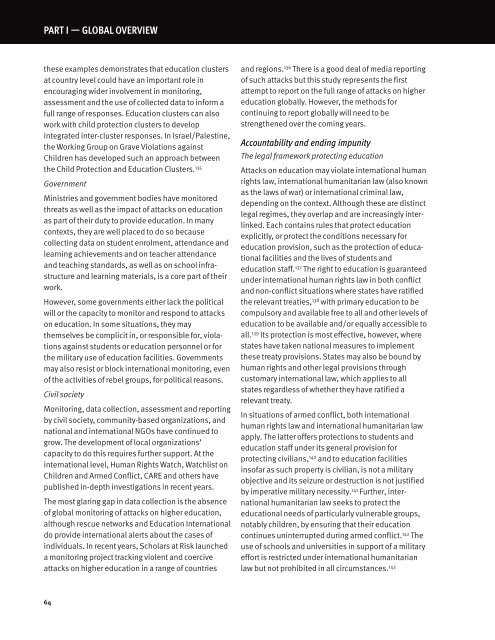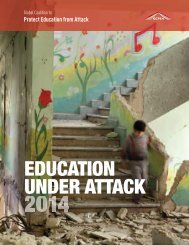Create successful ePaper yourself
Turn your PDF publications into a flip-book with our unique Google optimized e-Paper software.
PART I — GLOBAL OveRvIeWthese examples demonstrates that education clustersat country level could have an important role inencouraging wider involvement in monitoring,assessment and the use of collected data to inform afull range of responses. Education clusters can alsowork with child protection clusters to developintegrated inter-cluster responses. In Israel/Palestine,the Working Group on Grave Violations againstChildren has developed such an approach betweenthe Child Protection and Education Clusters. 135GovernmentMinistries and government bodies have monitoredthreats as well as the impact of attacks on educationas part of their duty to provide education. In manycontexts, they are well placed to do so becausecollecting data on student enrolment, attendance andlearning achievements and on teacher attendanceand teaching standards, as well as on school infrastructureand learning materials, is a core part of theirwork.However, some governments either lack the politicalwill or the capacity to monitor and respond to attackson education. In some situations, they maythemselves be complicit in, or responsible for, violationsagainst students or education personnel or forthe military use of education facilities. Governmentsmay also resist or block international monitoring, evenof the activities of rebel groups, for political reasons.Civil societyMonitoring, data collection, assessment and reportingby civil society, community-based organizations, andnational and international NGOs have continued togrow. The development of local organizations’capacity to do this requires further support. At theinternational level, Human Rights Watch, Watchlist onChildren and Armed Conflict, CARE and others havepublished in-depth investigations in recent years.The most glaring gap in data collection is the absenceof global monitoring of attacks on higher education,although rescue networks and Education Internationaldo provide international alerts about the cases ofindividuals. In recent years, Scholars at Risk launcheda monitoring project tracking violent and coerciveattacks on higher education in a range of countriesand regions. 136 There is a good deal of media reportingof such attacks but this study represents the firstattempt to report on the full range of attacks on highereducation globally. However, the methods forcontinuing to report globally will need to bestrengthened over the coming years.Accountability and ending impunityThe legal framework protecting educationAttacks on education may violate international humanrights law, international humanitarian law (also knownas the laws of war) or international criminal law,depending on the context. Although these are distinctlegal regimes, they overlap and are increasingly interlinked.Each contains rules that protect educationexplicitly, or protect the conditions necessary foreducation provision, such as the protection of educationalfacilities and the lives of students andeducation staff. 137 The right to education is guaranteedunder international human rights law in both conflictand non-conflict situations where states have ratifiedthe relevant treaties, 138 with primary education to becompulsory and available free to all and other levels ofeducation to be available and/or equally accessible toall. 139 Its protection is most effective, however, wherestates have taken national measures to implementthese treaty provisions. States may also be bound byhuman rights and other legal provisions throughcustomary international law, which applies to allstates regardless of whether they have ratified arelevant treaty.In situations of armed conflict, both internationalhuman rights law and international humanitarian lawapply. The latter offers protections to students andeducation staff under its general provision forprotecting civilians, 140 and to education facilitiesinsofar as such property is civilian, is not a militaryobjective and its seizure or destruction is not justifiedby imperative military necessity. 141 Further, inter -national humanitarian law seeks to protect theeducational needs of particularly vulnerable groups,notably children, by ensuring that their educationcontinues uninterrupted during armed conflict. 142 Theuse of schools and universities in support of a militaryeffort is restricted under international humanitarianlaw but not prohibited in all circumstances. 14364



